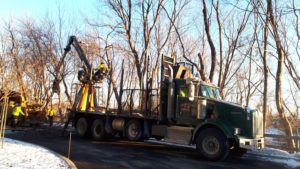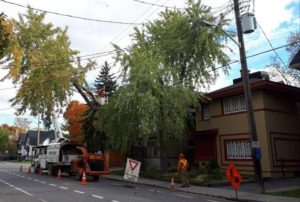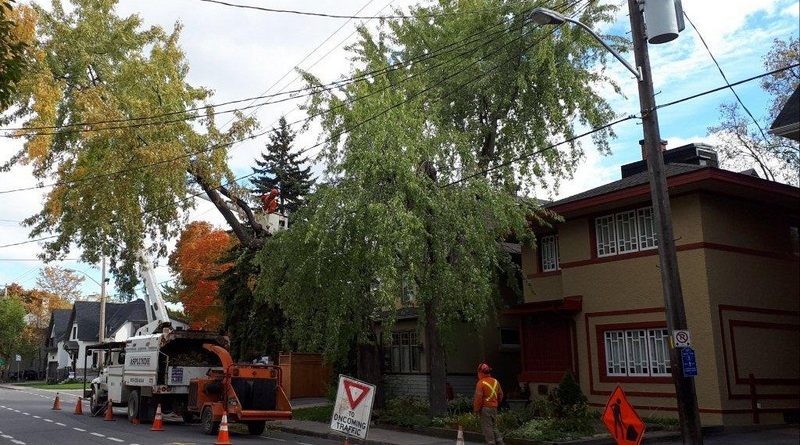How the City of Ottawa manages our trees
Bob Whitelaw
The City owns an estimated 330,000 street and park trees and works hard to keep them healthy. This responsibility is assigned to Public Works and Environmental Services and overseen by Forestry Field Operations and Forest Management.
Keelan Arnold, Program Manager, Forestry Field Operations and Tracey Schwets, Program Manager, Forest Management recently took time to provide information about the work of the Forestry Department in Sandy Hill—for example fallen trees, overhanging tree branches, rules and regulations, tree markings, replanting initiatives and programs of environmental sustainability and protection.
Information provided is focussed on City property tree issues. Different rules and regulations apply for trees on private property; it is important that residents with questions contact and work with City staff.

Photo Bob Whitelaw
Did you know that trees are important to a healthy and comfortable life in Sandy Hill? According to the City’s Urban Forest Management Plan at Ottawa.ca/urbanforest:
• Spending time around trees and in urban natural areas helps to reduce stress, anger, fatigue, sadness and anxiety and it also helps to increase energy.
• Evaporation from a single tree can produce the cooling effect of 10 room size air conditioners operating 20 hours a day.
• A tree’s shade provides natural protection against UV rays.
• A 10 x 10 km area with 25% tree cover can remove 90 tonnes of air pollution per year.
Call 311 to report fallen trees and branches on neighbourhood streets, sidewalks and public pathways. A representative will take the information, create an awareness file and forward the details to the appropriate section for inspection and remedial action. The 311 contact provides a central point to ensure that a file is started and follow-up on your call is monitored.
Sandy Hill is among the Ottawa wards assigned a Forestry Inspector with responsibility for oversight and follow-up of questions and/or concerns about tree issues. Among the responsibilities is a preventative maintenance program to monitor the health of trees.
Ongoing work includes regular pruning of trees which is one of the more common sights during the year. Pruning is based on several factors including insect and disease control and removal of overhanging branches which are a safety hazard for vehicles, pedestrians, streetlights or utilities. During winter months pruning helps to reduce damage from high winds, snow, and freezing rain. Thinning opens the canopy of a tree and reduces weight on heavy limbs. Another approach following storm damage can be crown restoration to remove damaged limbs thereby to restore stability to the tree, and to allow the tree to deal with wounds.
The tree trunks and branches are taken to landfill sites where the chips are used as “layering” as a benefit to the city. Only trees on City-owned portions of the roadway, in front and at the side of residential lots and parks are pruned.
Replanting of trees, known as the Trees and Trust Program, is an initiative to ensure the ongoing replacement of trees throughout Sandy Hill. Replacement options include a selection of different species depending on the locations and growth area. Diversity is a key in making decisions to ensure that one species does not dominate an area. While tree marking, cutting and trimming and disposal of trees and branches occurs throughout the year, the replanting programs are May / June and October / November.
Stump removal on City property along streets and sidewalks occurs during summer months when the soil and seeding of the area can provide cover.

Photo Bob Whitelaw
An important program for the Sandy Hill area is environmental sustainability and protection of the parks and the Rideau River embankments. City foresters work closely with the Rideau Valley Conservation Authority to ensure native species along the river. The broken and fallen trees and branches are left untouched to provide bank stability and natural habitat for animals and birds. Removal or pruning only takes place when there is an immediate impact or concern on the pathways, or if the fallen trees affect the course of the river.
